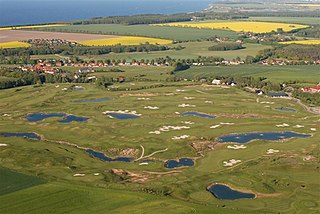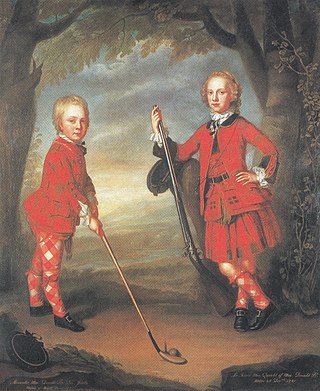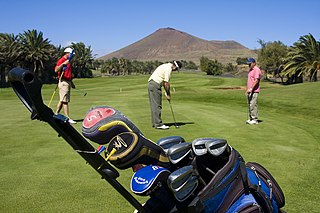
A golf course is the grounds on which the sport of golf is played. It consists of a series of holes, each consisting of a tee box, a fairway, the rough and other hazards, and a green with a cylindrical hole in the ground, known as a "cup". The cup holds a flagstick, known as a "pin". A standard round of golf consists of 18 holes, and as such most courses contain 18 distinct holes; however, there are many 9-hole courses and some that have holes with shared fairways or greens. There are also courses with a non-standard number of holes, such as 12 or 14.
A golf club is a club used to hit a golf ball in a game of golf. Each club is composed of a shaft with a grip and a club head. Woods are mainly used for long-distance fairway or tee shots; irons, the most versatile class, are used for a variety of shots; hybrids that combine design elements of woods and irons are becoming increasingly popular; putters are used mainly on the green to roll the ball into the hole. A set of clubs is limited by the rules of golf to a maximum of 14 golf clubs, and while there are traditional combinations sold at retail as matched sets, players are free to use any combination of legal clubs.

A golf ball is a ball designed to be used in golf. Under the rules of golf, a golf ball has a mass no more than 1.620 oz (45.9 g), has a diameter not less than 1.680 inches (42.7 mm), and performs within specified velocity, distance, and symmetry limits. Like golf clubs, golf balls are subject to testing and approval by The R&A and the United States Golf Association, and those that do not conform with regulations may not be used in competitions (Rule 5–1).
The following is a glossary of the terminology currently used in the sport of golf. Where words in a sentence are also defined elsewhere in this article, they appear in italics. Old names for clubs can be found at Obsolete golf clubs.
The following is a partial timeline of the history of golf.

The Olympic Club is an athletic club and private social club in San Francisco, California.
Stableford is a scoring system used in the sport of golf. Rather than counting the total number of strokes taken, as in regular stroke play, it involves scoring points based on the number of strokes taken at each hole. Unlike traditional scoring methods, where the aim is to have the lowest score, under Stableford rules, the objective is to have the highest score.
The following is a partial timeline of the history of golf.

The Tournament Players Club Sawgrass is a golf course in the southeastern United States, located in Ponte Vedra Beach, Florida, southeast of Jacksonville. Opened 44 years ago in the autumn of 1980, it was the first of several Tournament Players Clubs to be built. It is home to the PGA Tour headquarters and hosts The Players Championship, one of the PGA Tour's signature events, now held in March. Paul and Jerome Fletcher negotiated a deal with the PGA Tour, which included the donation of 415 acres (1.68 km2) for one dollar.

The origins of golf are unclear and much debated. However, it is generally accepted that modern golf developed in Scotland from the Middle Ages onwards. The game did not find international popularity until the late 19th century, when it spread into the rest of the United Kingdom and then to the British Empire and the United States.
The rules of golf consist of a standard set of regulations and procedures by which the sport of golf should be played. They are jointly written and administered by The R&A and the United States Golf Association (USGA). The R&A is the governing body of golf worldwide except in the United States and Mexico, which are the responsibility of the USGA. The rule book, entitled Rules of Golf, is updated and published on a regular basis and also includes rules governing amateur status.

The 33rd Ryder Cup, also known as the "Battle of Brookline", was held September 24–26, 1999, in the United States at The Country Club in Brookline, Massachusetts, a suburb southwest of Boston.

Golf equipment encompasses the various items that are used to play the sport of golf. Types of equipment include the golf ball, golf clubs, and devices that aid in the sport.
In the sport of golf, a penalty or penalty stroke is an additional stroke or strokes added to a player's score for an infraction of the rules. In match play, rather than adding strokes, the usual penalty is loss of the hole except for penalties assessed for relief from a hazard or a lost ball.

A putter is a club used in the sport of golf to make relatively short and low-speed strokes with the intention of rolling the ball into the hole from a short distance away. It is differentiated from the other clubs by a clubhead with a very flat, low-profile, low-loft striking face, and by other features which are only allowed on putters, such as bent shafts, non-circular grips, and positional guides.
The 1985 U.S. Open was the 85th U.S. Open, held June 13–16 at the South Course of Oakland Hills Country Club in Bloomfield Hills, Michigan, a suburb northwest of Detroit. Andy North, the 1978 champion, won his second U.S. Open title by a stroke over runners-up Dave Barr, Chen Tze-chung, and Denis Watson.

St. Louis Country Club (SLCC) is a country club located in Ladue, Missouri, a suburb of St. Louis. It is recognized by the United States Golf Association (USGA) as one of the first 100 Clubs in America.

The 1995 Open Championship was a men's major golf championship and the 124th Open Championship held from 20 to 23 July at the Old Course at St Andrews in St Andrews, Scotland. John Daly won his first Open Championship and second major title in a four-hole playoff over Costantino Rocca.

Golf is a club-and-ball sport in which players use various clubs to hit a ball into a series of holes on a course in as few strokes as possible.

The golf swing is the action by which players hit the ball in the sport of golf. The golf swing is a complex motion involving the whole body; the technicalities of the swing are known as golf stroke mechanics.













